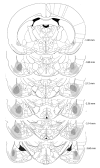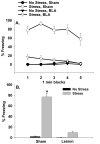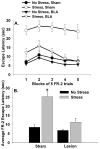Lesions of the basolateral amygdala reverse the long-lasting interference with shuttle box escape produced by uncontrollable stress
- PMID: 20226213
- PMCID: PMC2862138
- DOI: 10.1016/j.bbr.2010.03.012
Lesions of the basolateral amygdala reverse the long-lasting interference with shuttle box escape produced by uncontrollable stress
Abstract
Exposure to an uncontrollable, but not a controllable, stressor produces a constellation of behaviors called learned helplessness. In rodents, uncontrollable stress interferes with the ability to learn to escape from escapable shocks delivered in a shuttle box. The stress-induced shuttle box escape deficit is a common screening tool for potential antidepressant strategies. Inconsistencies in the literature exist regarding the time-course of, and mechanisms underlying, stress-induced escape deficits. When no common cues are shared between the stressor and testing environment, the escape deficit is short lived and independent of conditioned freezing. In contrast, when stress and testing occur in the same or similar environments, the escape deficit is very long lasting. The current studies address the hypothesis that the long-lived escape deficit produced by uncontrollable stress is dependent upon conditioned fear and the basolateral amygdala (BLA). Rats received bilateral excitotoxic lesions of the BLA 2 weeks following uncontrollable foot shocks. One week after surgery, rats were tested for conditioned freezing and escape behavior in the same shuttle boxes in which prior foot shocks were delivered. Stressed rats with sham lesions displayed robust conditioned freezing and failed to escape during shuttle box testing. Lesions of the BLA eliminated conditioned freezing and completely restored stressed rats' ability to perform the escape contingency. These data indicate that the long-lived stress-induced escape deficit produced under conditions in which the stressor and testing environments share common cues is dependent upon conditioned freezing elicited by the BLA. Results have important implications for the mechanisms underlying learned helplessness phenomena.
Copyright 2010 Elsevier B.V. All rights reserved.
Figures






References
-
- Chen AC, Shirayama Y, Shin KH, Neve RL, Duman RS. Expression of the cAMP response element binding protein (CREB) in hippocampus produces an antidepressant effect. Biol Psychiatry. 2001;49:753–62. - PubMed
-
- Desiderato O, Newman A. Conditioned suppression produced in rats by tones paired with escapable or inescapable shock. J Comp Physiol Psychol. 1971;77:427–31. - PubMed
-
- Drugan RC, Ryan SM, Minor TR, Maier SF. Librium prevents the analgesia and shuttlebox escape deficit typically observed following inescapable shock. Pharmacol Biochem Behav. 1984;21:749–54. - PubMed
-
- Fanselow M, Lester L. Evolution and Learning. Erlbaum; Hillsdale, NJ: 1988. A functional behavioristic approach to aversively motivated behavior: predatory imminence as a determinant of the topography of defensive behavior; pp. 185–212.
Publication types
MeSH terms
Grants and funding
LinkOut - more resources
Full Text Sources
Medical

